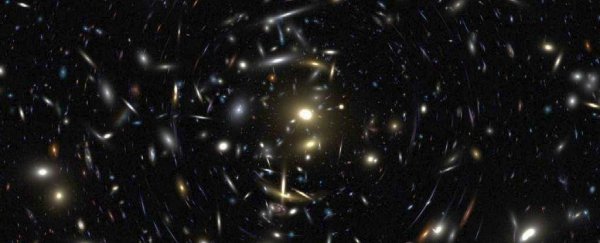A fresh look at Type 1a supernovae under a revised model of how the Universe is expanding has led researchers to suggest there might be no need for dark energy after all.
While there is currently a consensus that the fabric of space is stretching at an ever increasing rate, this new study has shown that – by replacing a few assumptions – our data on distant stars fits just as neatly without the need for mysterious, unexplained forces.
Researchers from the University of Canterbury in New Zealand have weighed in on a debate over how to best interpret the now famous signature of cosmic expansion found in the spectrum of light cast by distant objects known as Type 1a supernovae.
These kinds of stellar explosions are clearly identifiable and are generally accepted to have similar peak luminosities, making them ideal landmarks for astrophysicists to gauge extreme distances in space.
Based on subtle differences in the supernovae's colours, as observed by telescopes such as Hubble, it appears that the supernovae in the far distance are moving a little slower than those closer to us.
Since objects further away are virtual snapshots of past events, it's reasonable to conclude that the Universe's rate of expansion has been picking up steam.
For space to expand faster than the matter in it can pull together under gravity, there has to be something kicking it along.
Without any obvious candidates, physicists use the placeholder term 'dark energy'. If it exists, it would make up around 68 percent of the energy in the observable Universe.
It's not exactly a solid answer, but until a better theory emerges, dark energy is easier to say than 'all that stuff that's making the Universe expand quicker.'
In spite of being around for nearly two decades, the accelerating Universe and its mysterious cause are still regularly given a good kicking.
And for good reason – there are a number of assumptions we have to accept for this story to make sense.
For example, our position in space relative to other massive structures could influence the shape of space, which in turn could make a difference to how light moves through it.
We also assume that Type 1a supernovae are indeed good cosmic yardsticks, which could have some exceptions.
For the most part these assumptions make far more sense than any alternatives, and are unlikely to force any radical rethinks on the basic idea.
But one assumption could make the whole need for dark energy redundant, and has to do with a century old piece of mathematics called the Friedman equation.
This equation feeds into something called the Friedmann-Lemaitre-Robertson-Walker (FLRW) model of space, which describes the expansion or contraction of space with respect to general relativity.
This model of space is assumed to be like a vast rubber sheet, connected together and practically the same all over.
Of course the Universe isn't just a vast rubber sheet; if anything, it's more like a vast rubber sheet dotted with sand, marbles, and bowling balls, which in cosmological terms is called the Lambda Cold Dark Matter (ΛCDM) model.
Most of the debates over the changing shape of the Universe in the past 20 years have focussed on what kind of a difference those bowling balls should make to the expansion of space.
But University of Canterbury's David Wiltshire wondered what might happen if we challenged the underlying FLRW model itself.
"The past debate missed an essential point; if dark energy does not exist then a likely alternative is that the average expansion law does not follow Friedmann's equation," says Wiltshire.
Rather than weighing in on whether we should model the Universe as an empty sheet or cluttered with material, Wiltshire and his colleagues wondered what might happen if we used a model called timescape cosmology.
In this context, time and distance are calibrated in relation to the curvature of distinct locations between galaxies and voids. The implications are that it makes no sense to talk about a distinct age of the Universe as a whole.
Importantly, timescape cosmology doesn't have need of dark energy, as the differences in stretching light aren't the result of an accelerating Universe but rather an artefact of how we calibrate time and distance.
The team of researchers applied the timescape model to a large dataset of supernovae, and found it matched the changes in light-waves and luminosity with a likelihood that was indistinguishable from the ΛCDM model cosmologists currently favour.
None of this should be interpreted as a call to pack up shop and put dark energy into the filing cabinet.
For one thing, there would need to be a lot more evidence to convince the field to abandon one model for another, especially given there would be more at stake than just the question of dark energy.
But contrasting models can be a good way to make sure existing assumptions are reasonable and conclusions are watertight, while highlighting weaknesses that could potentially lead to improved solutions.
Dark energy isn't going anywhere soon. Time is ticking, however, and the day will come when we'll have a better idea of what lies in its shadows, if anything at all.
This research was published in the Monthly Notices of the Royal Astronomical Society.
